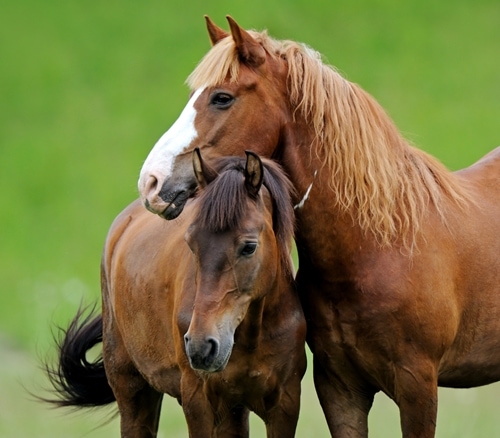The Messel Pit fossil site in Germany is renowned for its well-preserved fossils that date back to the Eocene Epoch, between 57 and 36 million years ago. But the discovery of an early horse species is garnering attention even among its impressive company.
Researchers unearthed the ancient equine (Eurohippus messelensis) that lived around 47 million years ago. The tiny specimen when full-grown was no bigger than a modern-day dog, and the fossil, with many of the bones in anatomical position, showed that the mare was carrying an unborn foal. The mare has four toes on its front foot and three on its rear feet. That’s right, the ancestors of the modern horse didn’t have hooves.
“It’s magnificently preserved,” Jens Lorenz Franzen of the Senckenberg Research Institute told Live Science. “It turned out this was an almost complete and articulated skeleton with a fetus.”
In many ways, the fossil gives horse owners a window into equine origins.
Well-preserved fossils
Franzen compared the fossil to the known phases of fetal development and birth in modern horses, and determined that the mare did not die during birth. The fetus was still facing upside down rather than having rotated into the right side up birth position. The X-ray analysis highlighted the broad ligament, a structure that connects the horse’s uterus to the backbone and helps support the developing fetus. Fascinatingly, the animal had a crumpled outer uterine wall, which is a feature that still exists in modern horses.
“Completely preserved skeletons of fossil horses are rare,” Bruce MacFadden, a professor and curator of vertebrate paleontology at the University of Florida, who was not involved in the study, told Live Science. “Usually, they’re fragmented and the bones are all dissociated. If you find a skeleton with a preserved foal inside, that indicates exceptional preservation, which is normally not found in the fossil record.”
The fossil was uncovered in 2000, but work on it started only two years ago. The relic was presented at the 2014 annual meeting of the Society of Vertebrate Paleontology in Berlin. Researchers hypothesize that the horse and other animals that lived during its time perished from the carbon dioxide gas emitted from volcanic activity.
The great equine animal wasn’t always as big and powerful as it is today. The modern horse developed from this smaller species, with toes instead of hooves and low-crowned teeth instead of grazing teeth. This means that the nutritional needs of horses has evolved quite drastically as well.
Fossil timeline
More ancient than the horse discovered in Germany, the oldest-known horse ancestor lived about 55 million years ago. Scientists said it had a primitive small face and a short diastema, which is the space between the front and back teeth. Although it had low-crowned teeth, the beginning of the horse-like ridges on the molars is apparent.
The earliest evidence of the little horse was unveiled in Wyoming, about 2 million years after its relative. Fossils have been found in Eocene sediments in several places in Wyoming as well as Oregon, dating from about 52 to 45 million years ago.
The crucial link to the modern equine, the species called Merychippus was a key part of the evolution of horses. While it retained the primitive look of three toes, the animal looked like a modern horse, with a long face, long legs and high-crowned cheek teeth, making it the first-known grazing horse and ancestor of all later horse lineages. Species in this genus lived from 17 and 11 million years ago.
Horse history has been rather eventful, with four major migrations.








